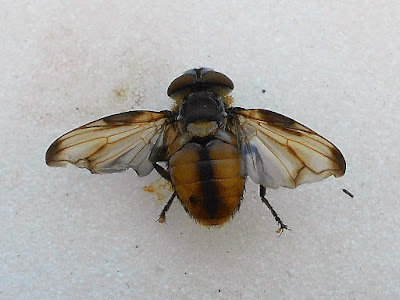The weather forecast predicted chilly conditions and I was tempted to give it a miss but, as it turned out, conditions were gloriously sunny and pleasantly warm. As a former geography teacher I appreciate how tricky forecasting can be in Britain, but too often the predictions are way off beam.
I parked up and a few minutes later was joined by Brian Harding, a dipterist from Oxfordshire. He and I wondered if we'd got the correct meeting point, for no-one else turned up.
 |
One of the main rides in Bucknell Wood, near Silverstone, Northants.
7 May, 2017
|
It is a fine woodland in terms of trees but the ground flora was quite limited. There were bluebells and primroses but nothing like the show currently to be seen in, for example, Badby Woods. The conditions were very dry but this ought not to affect the situation.
Anyway, relatively few bluebells but as a small compensation there was Greater Stitchwort, Stellaria holostea. In Northants it was first recorded in 1843 from 'Daventry Wood'. Where, I wonder, was that? Perhaps one of the woods clinging on to the slopes of Borough Hill?
The dominant tree was, as anticipated, Pedunculate Oak, Quercus robur. Here and there Oak Apples occurred. This gall is about the size of a golf ball and is soft and spongy.
Anyway, relatively few bluebells but as a small compensation there was Greater Stitchwort, Stellaria holostea. In Northants it was first recorded in 1843 from 'Daventry Wood'. Where, I wonder, was that? Perhaps one of the woods clinging on to the slopes of Borough Hill?
 |
| Greater Stitchwort at Bucknell Wood. 7 May, 2017 |
On the generally rather bare woodland floor the Wood Sedge, Carex sylvatica, was one of the few species to flourish. We have about 70 species of Carex here in Britain and a certain level of expertise is required to safely identify them. I do not have that expertise but am reasonably confident about this one.
 |
Wood Sedge on the rather bare woodland floor. Bucknell Wood.
7 May, 2017
|
 |
Oak Apples were occasionally to be seen. Bucknell Wood.
7 May, 2017
|
The insect responsible is a cynipid wasp, Biorhiza pallida, whose larvae induce this gross proliferation of tissue. At this time of the year the galls seem to be at their best.
In the trees a cuckoo, Cuculus canorus, was calling. I hope it finds a mate; small song birds will wish otherwise. I really can't remember the last time a heard a cuckoo. Sad.
In the trees a cuckoo, Cuculus canorus, was calling. I hope it finds a mate; small song birds will wish otherwise. I really can't remember the last time a heard a cuckoo. Sad.
In April come he will,
In May he sings all day,
In June he changes tune,
In July he prepares to fly,
In August go he must.
Trad.
Trad.
In fact most adults have left by late July and the juveniles depart a month or so later. Who or what guides them down to equatorial west Africa? This remains one of nature's unsolved mysteries. (Ed. What do you mean, 'unsolved mysteries'? If it is a mystery it is obviously unsolved!)
What of the insects? Beside the main ride a group of extraordinary moths were 'dancing'. They were Green Longhorn Moths, Adela reaumurella, and the photograph shows the extraordinarily long antennae, nearly four times as long as the forewings, which give this widespread species its common name.
 |
| A Green Longhorn Moth at Bucknell Wood. 7 May, 2017 |
I should also mention the strange-looking tachinid fly, Phasia hemiptera, also taken along the main ride. Tachinids are parasites of a range of other invertebrates including butterflies, moths, earwigs and centipedes. Phasia hemiptera is typically found at the margins of woods where it is known to parasitise the shieldbug, Palomena prasina.
 |
A male specimen of Phasia hemiptera, taken at Bucknell Wood. 7 May, 2017
|
Sure enough, on foliage nearby were numbers of these green shieldbugs, some of them mating, in a position not to be found in the Kama Sutra - or so I'm told!
 |
A pair of Green Shieldbugs, Palomena prasina, mating.
Bucknell Wood. 7 May, 2017
|
My final photograph I almost didn't include in this blog. It is the caterpillar of a widespread moth known as The Brick, Agrochola circellaris. When I parked my car I noticed a scattering of Wych Elm, Ulmus glabra, fruits on the ground. This is one of the larval food plants of The Brick although sallow, poplar and ash are also acceptable. The blackish triangular dorsal markings are typical and diagnostic. I found it on the soil surface among dead leaves but this is to be expected as it lies dormant there for about six weeks before it forms a cocooned pupa.
 |
Larva of The Brick, a noctuid moth. Bucknell Wood, Northants.
7 May, 2017
|
Apparently the adult is often brick coloured - but a brick can be red, yellow (in London), brownish or grey. The name doesn't tell us a lot!
Tony White. E-mail: diaea@yahoo.co.uk
Tony White. E-mail: diaea@yahoo.co.uk
No comments:
Post a Comment